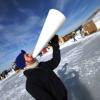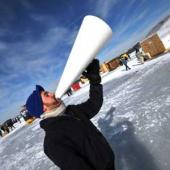Interaction and connection
Editorial
 As a director, I’ve made a practice of developing theatrical events that take place outside conventional theater spaces. I love language, music, and narrative, but Space speaks to me. Space defines the boundaries of interaction, and unconventional spaces force deeper connections with the audience. And I believe that it is interaction and connection that make the live experience special.
Often in a conventional theater setting the piece is delivered to the audience – framed by the familiar architecture we associate with live art (controlled acoustics, darkness, theater seats), everyone can see and hear basically the same thing. In site-specific work, individual participants have unique encounters with the piece. For example, you might turn a corner and spot a scene about to begin, or peer through a window to see a character rocking in a chair, or come off the elevator to witness a scene in progress. In site specific performance the audience is, more often than not, ready for anything. In mobile works, the audience is on their feet, ready to move and respond.
In conventional theater, I find that audiences tip back into their seats, sedated, seduced by the darkness, and the controlled harmony of story and space. Even with the best material and the gutsiest actors, audiences can be complacent and their expectations inert. But, in many ways, I’ve found that producing and creating site-specific work is an amazing opportunity to connect with audiences in a new way for everyone.
As a director, I’ve made a practice of developing theatrical events that take place outside conventional theater spaces. I love language, music, and narrative, but Space speaks to me. Space defines the boundaries of interaction, and unconventional spaces force deeper connections with the audience. And I believe that it is interaction and connection that make the live experience special.
Often in a conventional theater setting the piece is delivered to the audience – framed by the familiar architecture we associate with live art (controlled acoustics, darkness, theater seats), everyone can see and hear basically the same thing. In site-specific work, individual participants have unique encounters with the piece. For example, you might turn a corner and spot a scene about to begin, or peer through a window to see a character rocking in a chair, or come off the elevator to witness a scene in progress. In site specific performance the audience is, more often than not, ready for anything. In mobile works, the audience is on their feet, ready to move and respond.
In conventional theater, I find that audiences tip back into their seats, sedated, seduced by the darkness, and the controlled harmony of story and space. Even with the best material and the gutsiest actors, audiences can be complacent and their expectations inert. But, in many ways, I’ve found that producing and creating site-specific work is an amazing opportunity to connect with audiences in a new way for everyone.

Pursuing puzzle pieces
Whether in totally fabricated environments like The Children's Theater Company's production of Romeo and Juliet in their Cargill stage or on the back patio of a residence in the Mac-Groveland neighborhood, as with Skewed Visions' production of He Woke Up In A Strange Place Called Home And Although Looking For Bed He Kept Finding Death Instead, I love watching the audience become curious, watching them pursue each piece of the puzzle—pursuing characters, pursuing ideas in tandem with the organic "clock" of the performance. Another one of my favorite site-specific experience was Small Metal Objects—its audience placed in the Walker Sculpture Park, facing south as the action unfolded amidst the regular traffic of a lively Saturday afternoon. One of my own projects, Mpls Pinter Studies, was a promenade evening inspired by the short works of Harold Pinter. We wanted to challenge independent artists and groups to create short "chamber" work within the Colonial Warehouse Building—its hallways, elevators, corridors and basement storage facilities. In another project, Orpheus and Eurydice: A Picnic Operetta, an opera created for community garden spaces, we served a five-course sampling menu. We wanted to present our audience with a tangible connection between the story and the space of performance. With our community gardens operetta, our story, myth, and music unfolded within urban agriculture, embodying our concept of renewal. Though it may appear to be a liability, I've found performing in found spaces to be luxurious. Because found spaces often come with a variety of amenities. When you ask simple, practical questions, you often discover simple, wonderful solutions: How do people and animals move through this space? What makes this space topographically specific? Just as gardeners and landscape architects use spaces to maximize the surface area and support the productivity of plants, theatermakers can look at the same space to promote interaction and serve narrative. Every slope and twist and crack can reinforce dramatic action. One of the most important luxuries of site specific performance is that it is unmistakably alive, i.e. life happens all around the performance, and a real life experience is had by all the artists and participants together. At our "picnic operetta" in the garden, random pedestrians, squirrels, clouds, and worms added to the live-ness of the story. The food we prepared and consumed in our "kitchen garden theater" was partially grown on the sites of the performance. Just as wine and grapes develop their characteristics from the qualities of soil, climate, and topography they are grown in, our opera mixed with the urban sounds and local flavors to bring old, sometimes moldy, characters out of ancient Greece and into local neighborhoods—where the audience experiences the unique terroir of the performance site. Of course, there have been struggles: Bugs, barking dogs, gusts of sand blowing through the action, plus confused janitors, unexpected vacuum-cleaning sounds, and elevators that don't work. Audience security and actor safety can be compromised in these temperamental and unpredictable spaces.
Yet even with these dangers, I'm constantly imagining the live experience available in many settings. How about freeway overpasses, shopping mall rotundas, maple groves and meadows? All have their own unique landscape, dynamics, and tactile surfaces to explore. Artists can frame the potential for magic in these structures while the audience personalizes the experience.
In the best possible scenarios, interaction transforms the space from just another hallway to a site of human connection.
Of course, there have been struggles: Bugs, barking dogs, gusts of sand blowing through the action, plus confused janitors, unexpected vacuum-cleaning sounds, and elevators that don't work. Audience security and actor safety can be compromised in these temperamental and unpredictable spaces.
Yet even with these dangers, I'm constantly imagining the live experience available in many settings. How about freeway overpasses, shopping mall rotundas, maple groves and meadows? All have their own unique landscape, dynamics, and tactile surfaces to explore. Artists can frame the potential for magic in these structures while the audience personalizes the experience.
In the best possible scenarios, interaction transforms the space from just another hallway to a site of human connection.




